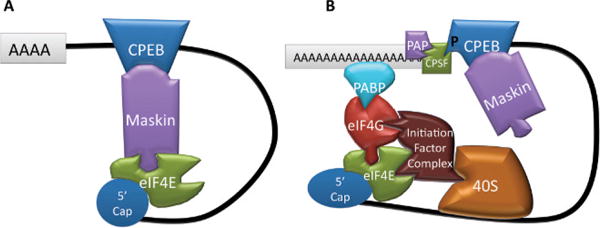Figure 3.

Regulation of cytoplasmic polyadenylation element– binding protein (CPEB) function by phosphorylation. (A) When not phosphorylated, CPEB will hold the transcript inactive by association with Maskin. Maskin binds EIF4E competitively inhibiting binding by eukaryotic translation initiation factor 4G (EIF4G). This activity is encouraged by the maintenance of a short poly(A) tail. (B) Once phosphorylated, CPEB binds to cleavage and polyadenylation–specific factor (CPSF) that associates with polyadenylate polymerase (PAP). This lengthens the poly(A) tail, causing poly(A)-binding protein (PABP) binding. This encourages association with EIF4G. This occurs in conjunction with a loss of affinity of Maskin for EIF4E, although Maskin remains bound to CPEB. Together, this causes the initiation complex to form and encourages the small ribosomal subunit to bind, which is a limiting step for translation initiation.
